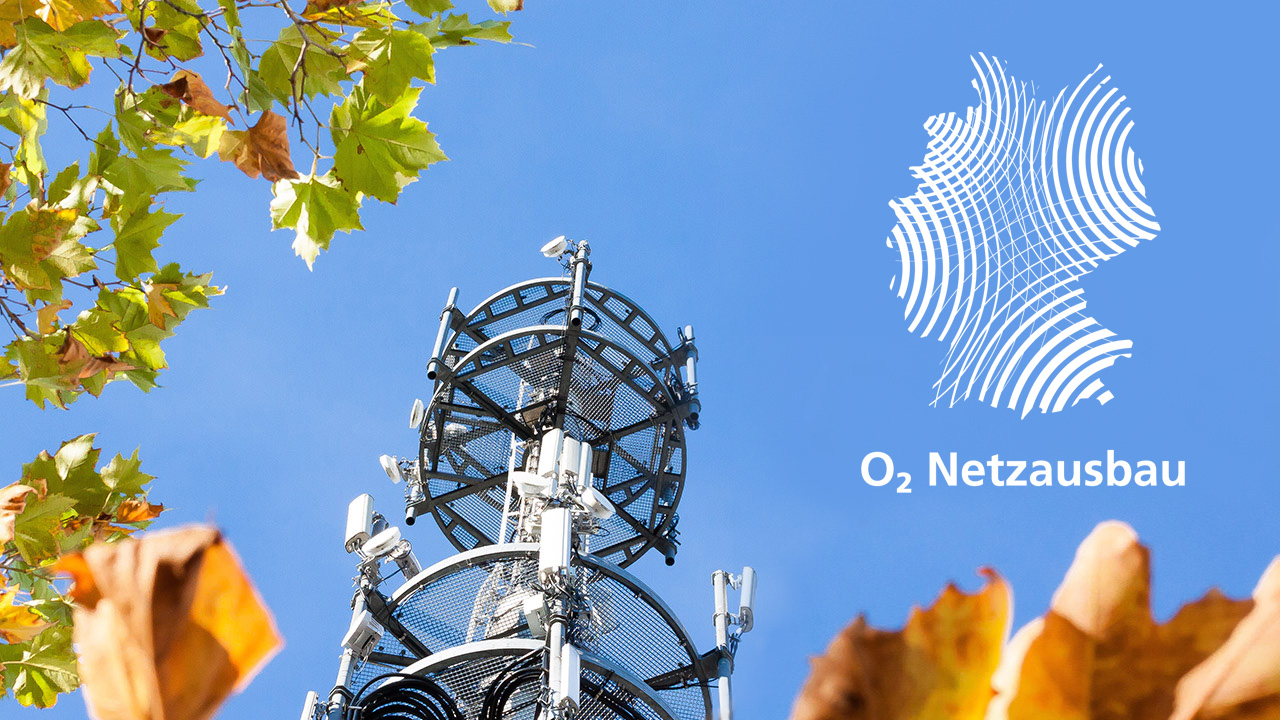14.11.2019
More LTE, higher speeds and more stable connections:O2 customers benefit from LTE network expansion
Telefónica Deutschland is consistently pushing ahead with LTE expansion
Telefónica Deutschland is implementing the largest LTE expansion program in the company's history. The company consistently pushed ahead with the expansion of the O2 LTE network in October and put more than 550 new LTE transmitters into operation. This has improved broadband coverage and LTE capacities in all 16 federal states. The comprehensive network expansion measures are having a positive effect on the digital everyday lives of O2 customers and are also visible in the latest analyses - customers are getting more LTE, higher speeds and more stable connections.
In the current network test conducted by Smartphone Magazine, the O2 network scored "good" and, in combination with its attractive O2 Free tariffs, won the price/performance award. Telefónica emerged as the best network operator for second and partner brands in the recently published Mobile Discounter Check 2019 by the trade magazine connect.
Improved LTE network for O2 customers
The LTE expansion program and the resulting quality improvements directly benefit O2 customers:
- Higher speeds: O2 customers use average speeds of 39.2 Mbps. In the previous year, the figure was 30 Mbit/s. This allows them to use all digital applications smoothly. For example, around 5 Mbit/s are required for smoothly playing YouTube videos. Even for streaming in HD quality, e.g. Sky recommends a network speed of 8 Mbps.
- Better LTE coverage: The network expansion measures of recent months have provided more than three million additional people with LTE. In addition, more than 60% of German households already have an LTE network that provides data rates of over 100 Mbps.
Thanks to the LTE-expansion programm O2 customers will browse and take phone calls in enhanced quality in all 16 federal states
- Larger LTE network: Several thousand new LTE transmitters ensure an even better network experience in the O2 LTE network in numerous communities.
- More LTE in the display: Due to the significant increase in LTE availability, around 85 percent of customers' data volume - including own brands and partner brands - is transmitted via the LTE network, which is around 20 percent more than in the previous year. Most data traffic today is handled via the LTE network - which is why the mobile communications standard will continue to form the backbone of the network infrastructure in the future.
- More stable phone calls: O2 customers can make phone calls en route for much longer without any dropped calls. Compared to the beginning of the previous year, stability has increased by 25 percent. Thanks to Voice over LTE (VoLTE), they can make calls in the LTE network with the best HD voice quality anyway.
The available network capacities are very well accepted by O2 customers. Since the beginning of the year, data consumption has increased by more than 50 percent. For comparison: 31.8 GB per second run via the O2 mobile network - this is the data volume of all eight seasons of the successful series Game of Thrones. The network is well on its way to breaking the 1 billion gigabyte (1 exabyte) mark this year. For this reason, Telefónica Deutschland will continue to push ahead with network expansion with extensive measures in the coming months.
LTE expansion in October: New LTE stations in all federal states
As part of the expansion programme in October, Telefónica Germany supplied numerous towns and communities nationwide with new LTE coverage. These include the residential town of Greiz in Thuringia, the Baltic seaside resort of Graal-Müritz in Mecklenburg-Western Pomerania, Glatten in the northern Black Forest, Bad Grund in the Harz Mountains, Glashütten in Upper Franconia, Spremberg in Brandenburg, Rauenthal in the Rheingau-Taunus district of Hesse, and Sohland on the Spree in Saxony. In addition, there were various LTE capacity upgrades in large and small towns.
Since October, O2 customers in many regions also have better LTE coverage on motorways, federal highways and ICE routes. This includes, for example, new LTE coverage for the Wittstock/Dosse motorway junction (A19 and A24) in Brandenburg. O2 customers now also have improved LTE reception on the A4 near Olpe, the A8 near Olching (Fürstenfeldbruck), the A14 near Staßfurt (Salzlandkreis), the A19 near Fünfseen (Mecklenburg Lake District), the B6 near Oschatz (Nordsachsen), the B14 near Heilsbronn (Ansbach), the B85 near Roding (Cham) and the B211 near Ovelgönne (Wesermarsch).
In October 2019, Telefónica Deutschland added LTE to existing GSM/UMTS stations in the following districts and cities, among others, thereby improving LTE coverage:
- Baden-Württemberg: Biberach, Böblingen, Freudenstadt, Göppingen, Mannheim, Ostalbkreis, Rastatt, Rottweil, Tübingen, Zollernalbkreis
- Bavaria: Altötting, Amberg-Sulzbach, Ansbach, Bamberg, Bayreuth, Cham, Coburg, Dachau, Erding, Freyung-Grafenau, Fürstenfeldbruck, Günzburg, Hof, Ingolstadt, Kaufbeuren, Landsberg am Lech, Landshut, München, Neustadt an der Aisch – Bad Windsheim, Oberallgäu, Ostallgäu, Regensburg, Rottal-Inn, Straubing-Bogen, Weilheim-Schongau, Weißenburg-Gunzenhausen
- Berlin: Berlin
- Brandenburg: Cottbus, Elbe-Elster, Ostprignitz-Ruppin, Spree-Neiße
- Bremen: Bremen, Bremerhaven
- Hamburg: Hamburg
- Hesse: Frankfurt am Main, Kreis Groß-Gerau, Rheingau-Taunus-Kreis, Wiesbaden
- Mecklenburg Western Pomerania: Ludwigslust-Parchim, Mecklenburgische Seenplatte, Nordwestmecklenburg, Rostock, Schwerin, Vorpommern-Greifswald
- Lower Saxony: Aurich, Cloppenburg, Emsland, Göttingen, Harburg, Leer, Osnabrück, Nienburg/Weser, Region Hannover, Vechta, Verden, Wesermarsch
- North Rhine-Westphalia: Aachen, Bochum, Düsseldorf, Essen, Herne, Krefeld, Kreis Borken, Kreis Coesfeld, Kreis Mettmann, Kreis Minden-Lübbecke, Kreis Olpe, Kreis Recklinghausen, Kreis Steinfurt, Kreis Unna, Kreis Viersen, Kreis Warendorf, Kreis Wesel, Mönchengladbach, Mülheim an der Ruhr, Oberbergischer Kreis, Solingen, Wuppertal
- Rhineland Palatinate: Germersheim, Mayen-Koblenz
- Saarland: Neunkirchen
- Saxony: Bautzen, Chemnitz, Leipzig, Mittelsachsen, Nordsachsen, Zwickau
- Saxony Anhalt: Magdeburg, Salzlandkreis, Stendal
- Schleswig-Holstein: Flensburg, Kreis Dithmarschen, Kreis Schleswig-Flensburg, Kreis Ostholstein, Kreis Stormarn
- Thuringia: Gera, Greiz, Schmalkalden-Meiningen, Sonneberg, Weimar

